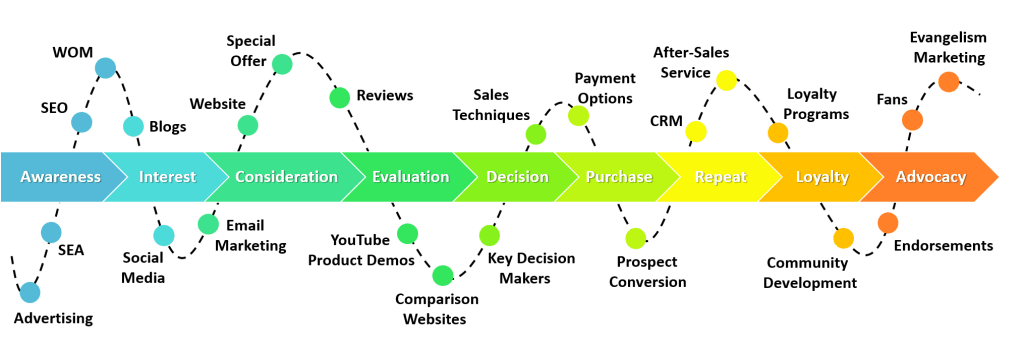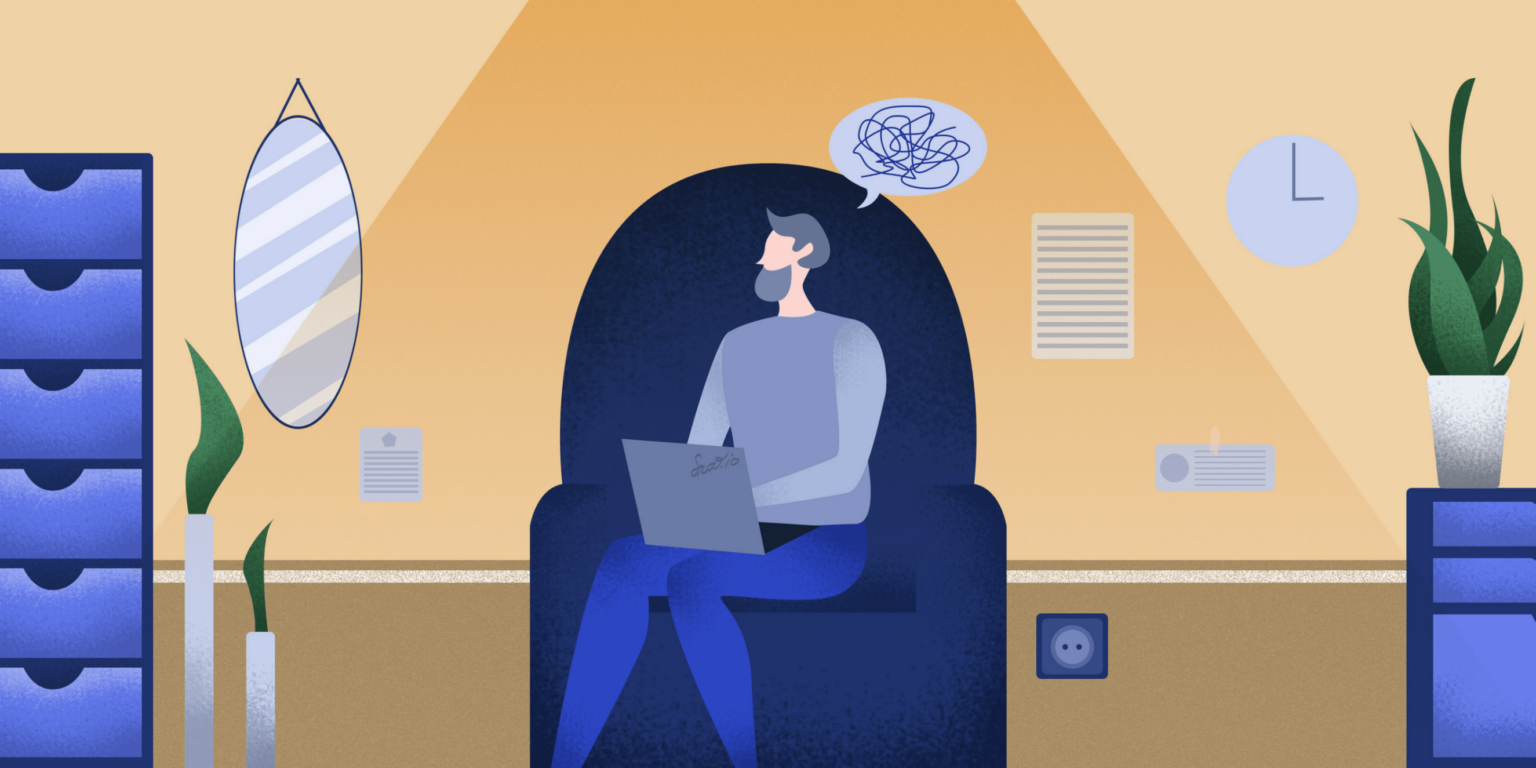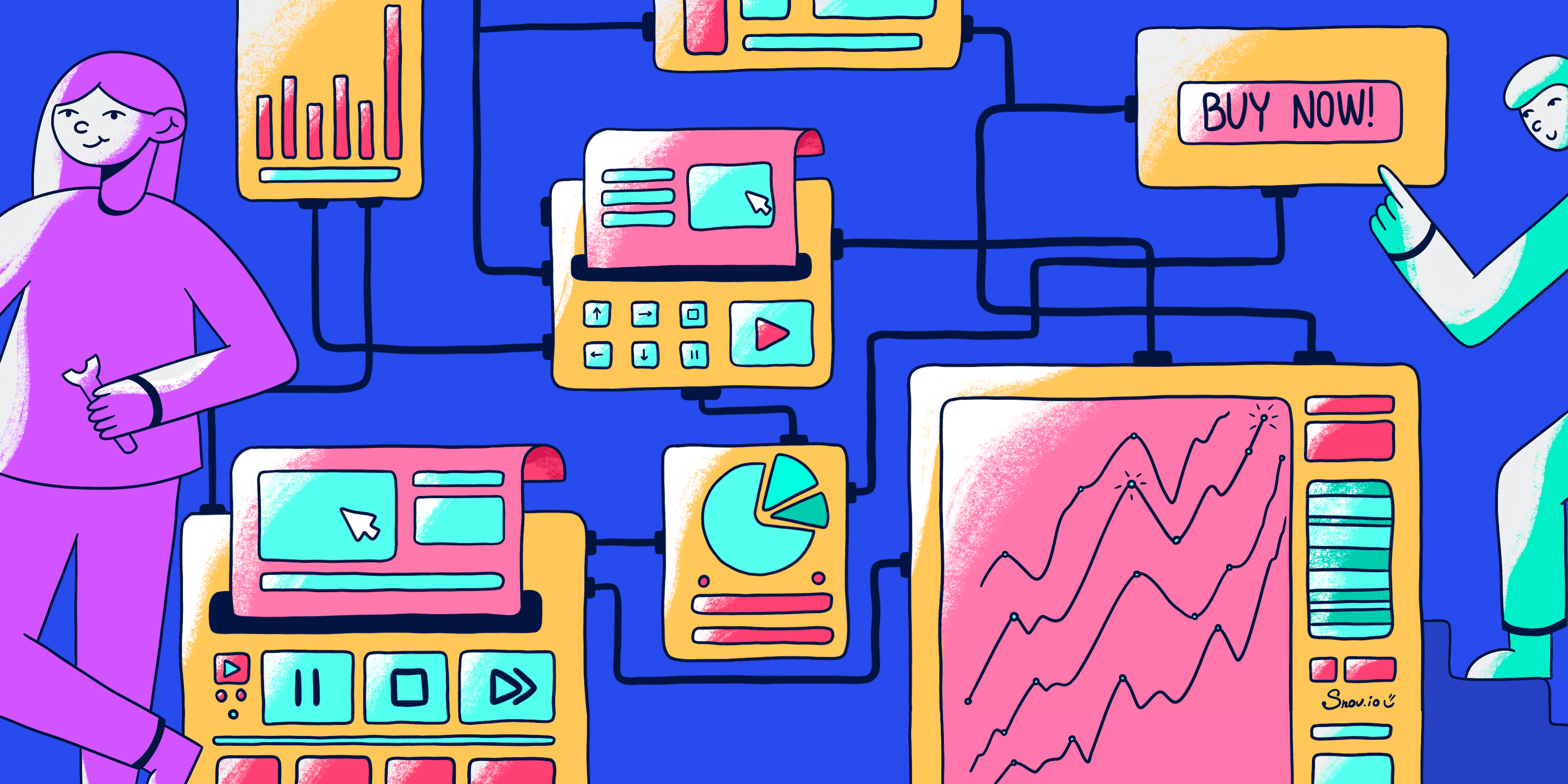Life is a journey, and so is marketing and sales. It’s a buyer’s journey—a path your potential clients take from being a target audience to the awareness, consideration, and decision-making stages. And, like every journey, a sales funnel must end in a final conversion.
But before you get to that final conversion, make sure you collect high-quality prospects according to your ICP. This is the crucial step in sales.
So let’s take a look at the conversion goals and means for every stage of the buyer’s journey.
There are three main stages in every prospect’s buyer journey:
- Awareness Stage – when a person discovers your company, product or service
- Consideration Stage – when a person takes an interest in your product or service
- Decision Stage – the final stage, when a person makes a decision to buy from you
Each of these stages can be applied to any marketing funnel, no matter what the source or the channel is. It’s worth noting that sometimes the buyer’s journey (aka customer journey) is depicted in more detail with over half a dozen stages, like in this graph:

However, awareness, consideration, and decision stages are the three key ones. We will discuss these three buyer’s journey stages through the lens of email marketing and drip campaigns and show you what content and approaches can be used at each stage to convert more people into the next one. You can download this detailed guide in infographic form here: Awareness, Consideration, Decision: How To Convert AT Every Stage Of The Buyer’s Journey.
Awareness stage
Awareness is the first stage of the customer journey. During this stage, the customer realizes their problems and tries to define their own pain points. This is when they come across your service or company – while researching their problem. At this point, it’s important to provide the targeted audience with more information about your company or products in a calm and educational way. The less salesy and promotional your content is, the better – the person is not loyal to your brand yet, so it’s easy to scare off your potential client if you get pushy.
Numbers show us just how important it is to help the customer in their research if you want to convert them further: 81% of shoppers research before buying, with 75%* of time shopping is spent on research only. Before you make your move, make sure you can answer the following questions:
✔ What are the buyer’s challenges and goals?
✔ How do buyers educate themselves on their goals and challenges?
✔ What are the results of doing nothing?
✔ How do buyers prioritize their goals?
There are multiple types of free content you can use in your email sequences to convert more people from Awareness to Consideration stage. It’s best if this content is easily sharable – in B2B there is on average 7-20 people involved in the purchase process:
- Whitepaper
Works well for enterprise-level businesses or projects that have complex structures or mechanisms behind them. Whitepaper is a serious piece of educational content that contains bigger research, explains methodology or describes company’s approaches. It can contain both market and product data. - Detailed guide
Works for any type of business, as such content is purely educational and relates to your product or service. It should educate first, promote second. It’s best to write your guide in a how-to style so it’s not just educational, but also practical. - Free e-book
E-books serve the same purpose as the guides, but with even more useful content. People love e-books because you can save them as a pdf, read them later, share them with friends and colleagues and more. They are also perfect for evergreen or viral content and as lead magnets: once you’ve created an interesting and useful e-book that is related to your niche, you can use it, again and again, for months and even years.
- Practical checklist
A practical piece of content works great for any type of business. Checklists can be used as a questionnaire that helps identify problems that need to be solved, or as an action list that pushes your target audience to act and use your product or service. - Educational videos
Videos are an easy-to-digest type of content that can explain and offer solutions to the potential customer’s problems in just a few minutes. Videos can also be used as viral or evergreen content. Just remember to keep them educational first. - In-depth articles and expert content
Probably the most common type of content that is used at this stage of the sales funnel. You can use articles that have already been published on your blog or create new ones specific to your current email marketing and drip campaigns. When creating an article, make sure it’s useful and educational, and your call-to-action looks organic and casual.
To make your content easy to discover, use stage-specific SEO keywords. For this buyer’s journey stage, “how-to”-queries are the most common. Here are a few examples:
- how to find emails online
- how to find leads
- how to find clients online
- how to find clients for {{your_business}}
- find emails online
- find emails on {{social_network}}
- find email addresses
- find someone’s email address
- generate leads online
- how to generate leads
As you can see, this stage relies heavily on shareable, optimized, educational content that helps your potential customer, not sells to them.
Consideration stage
Consideration is the second stage of the buyer’s journey. At this step, the potential customer is a little familiar with your product or service, and is evaluating the problem, its urgency, how it can be solved, and whether it really needs to be solved here and now. Your goal is to show them all the ways their problem can be solved, how beneficial it will be for them and how you and your product can help. You also need to show how you are better than the competitors.
At the consideration stage, 60%* of customers want to get in touch with a sales manager. Make sure your sales reps are ready to answer any customers’ questions, but first see if you can answer the following:
✔ What types of solutions are the buyers searching for?
✔ How do buyers educate themselves on these solutions?
✔ How do they realize the pros and cons of every alternative?
✔ How do customers decide on the best option?
Once again, content can help you convert more people from consideration to the decision stage of the buyer’s journey:
- Free webinars
One of the best content types to convert your audience from consideration to the decision stage. Webinars allow you to speak to a bigger audience and create a dialogue between you and your potential customers. It’s a good idea to make your webinar half-educational/half-promotional: start with some useful tips and tricks, and then show how your product helps with the problems they are facing. - Case studies
This is a piece of content that cannot be overrated. Case studies are what many potential clients at the consideration stage are looking for, as these are the best demonstration of how your product or service helped other businesses. Case studies help convert like crazy, just make sure they are detailed enough in terms of the niche, the business, the problems, the solutions, and the results. The more elaborate and number-rich your case study is, the better. If you have any case studies – don’t hesitate to include them in your email marketing. - Free samples
People love freebies, and if your business type allows you to send some free samples of your product, don’t hesitate to use them in campaigns. This doesn’t just work for physical products, for digital products it could be free reports, free analysis or anything similar. It’s important to always remind people of the value of your free samples – it should be considered a generous offering, not a random default giveaway of whatever you couldn’t sell. If possible, make your free sample personalized. - Specification sheets
Works best when you need to provide your target persona with more details on your product or service. This type of content is widely used by businesses that sell software, tools, technical services, platforms, automation tools and the like. Make sure to include features, benefits and even some case studies in your spec sheets, not just technical data. A call-to-action to request a specification sheet can be easily incorporated into your email marketing. - Catalogs
Catalogs is a must-have piece of content if you offer multiple products or services. Make it more educational by including use-cases and tips to specifications and descriptions. You can easily put a call-to-action to download or request a catalog into an email.
As for SEO, these are the queries that work best at this stage (as shown on our own example of the email finder tool):
- email hunter
- email finder(s)
- email finders comparison
- email finders alternatives
- email finder extension
- {{your_company}} alternatives
- {{your_competitor}} alternatives
- {{your_company}} vs {{competitor}}
- {{your_company}} and {{competitor}} compared
Decision stage
The decision-making stage is the final – conversion – stage of the buyer’s journey, at which your potential customer makes a decision based on their research. Your goal is to help them make a positive decision and finally become your client. That’s when the final conversion happens.
By this stage a target person has become more loyal to you and you should use this to educate less and promote more. 65% of B2B customers claim that the vendor’s content influences their buying decision, so this is your time to shine. As always, make sure you can answer these journey stage-specific questions:
✔ What do customers appreciate about your offer the most?
✔ What scares them off?
✔ How many people are involved in the decision-making process?
✔ What influences the decision?
✔ Do buyers expect a trial before making the final decision?
✔ Do prospects have to make any preparations before making a purchase?
If your sales reps did a good job at the previous stage, you won’t have a problem answering these questions.
As for the content, the best promotion is the product/service itself, so here’s what you can offer to improve conversions:
- Free trial
Works great for digital products. If you sell software, digital services, or tools, allow your potential clients to try it for a week, two or even a month. Once your potential client sees the benefits and results, you can be sure they won’t just leave. Put a call-to-action to try your product or service for free into your email copy. - Demos
Similar to a free trial, but instead of letting your potential client test it on their own, you show them how your product or service works based on their specific needs. Demos are usually held by sales reps or account managers, and they can convert a person to a client right during at the demo. A demo is a good chance to offer a coupon or a discount that works for a limited time (we will discuss this later in the article). Make sure to offer your target audience to schedule a demo in your emails. - Expert opinion
Similar to a consultation, an expert opinion is usually more focused on assessing the potential client’s problem by an expert and providing them with expert advice on how to solve it. An expert opinion is more personalized and private. You can use a CTA in your email campaigns that offers to schedule a meeting with your in-house expert. - Estimates and quotes
A piece of personalized content that is very close to the actual conversion. When a person requests a quote or you’ve successfully marketed your quote, it means that the potential client is really “hot”. Make sure to add more info with your quote and mention the benefits – for example, a one-off payment instead of a recurring fee, or a volume discount that was applied to the price. Include a CTA for a quote request in your emails to see how many of your potential clients are truly interested and willing to become your clients. - Coupons and discount codes
Probably the most well-known method of converting people that are going through the last stage of the buyer’s journey. Just a few advice for better conversion: if you send out coupons to all of your leads on the decision stage, make sure to use a randomized code that looks like AF984WTB – this way it feels personal, as it’s been created for a specific client only. A good practice is to use a CTA to request a coupon or a discount – thus you can evaluate and score a person before providing them with a discount.
Here’s all the data you’re going to need in organizing your buyer’s journey content in the form of a shareable infographic:

Conclusion
Different stages of the buyer’s journey require different types of content to convert a person from one stage to another, as well as make the final conversion to a client.
For the awareness stage, use content that is at least 90% educational and just 10% promotional. Remember that a potential client has just stumbled upon your business and they can easily be scared away by content that’s too promotional or pushy. Make your content feel and look useful, interesting and shareable.
For the consideration stage, use content that helps understand the problem, the value of your solution and the results your client can get. The more value-showing your content is the better. Keep it 30% educational and 70% promotional. Remember: focus on the problem, your solution, and positive results.
For the decision-making stage, use content that helps you actually sell your product or service. Personal contact in the form of a demo or an expert opinion is a great chance to showcase your expertise, your product and win the deal. Your content should be 90% promotional and maybe just 10% educational – your goal is to sell now, at this stage your potential client is already “hot”.
Which content do you use to improve your conversions in the buyer’s journey? Let us know in the comments!
*All data sources are noted in the Resources part of the infographic above.


